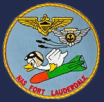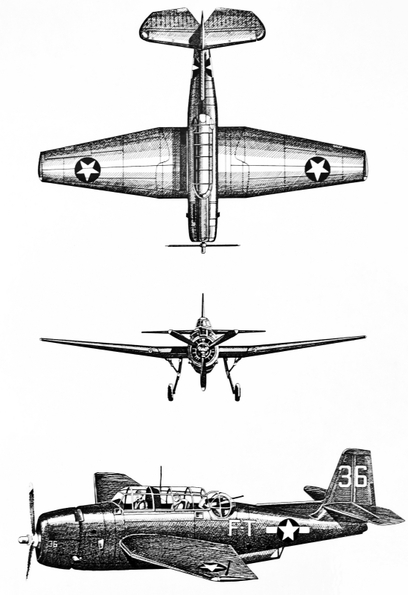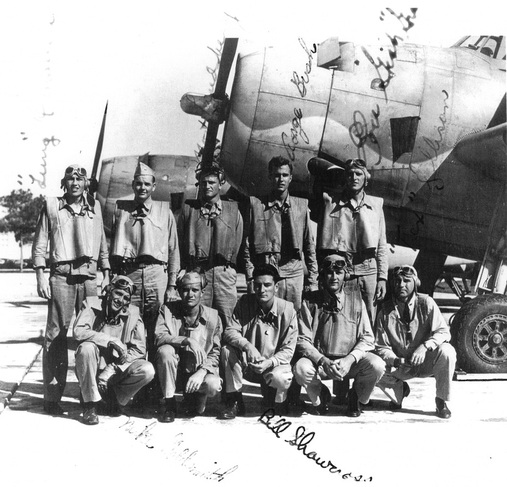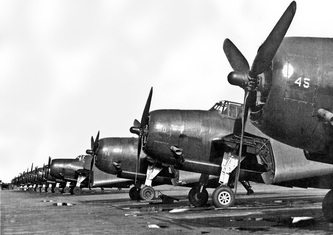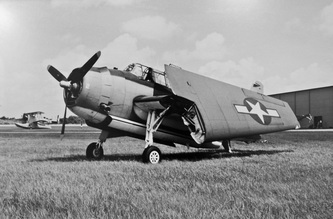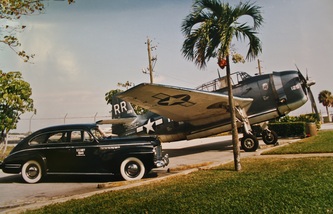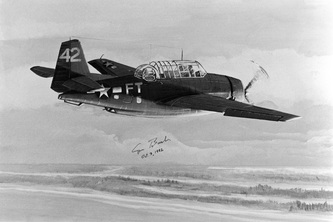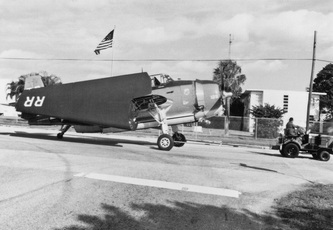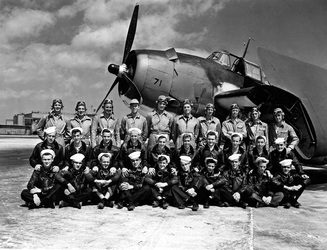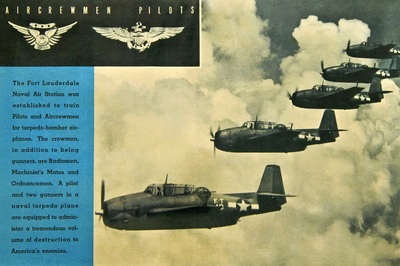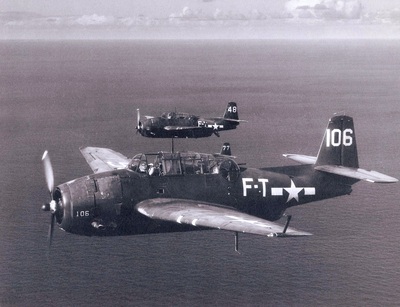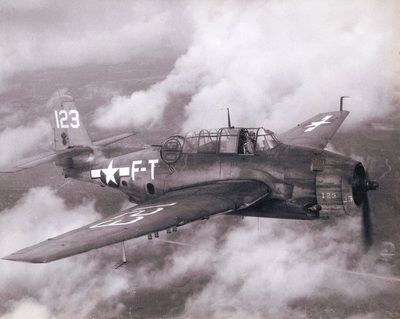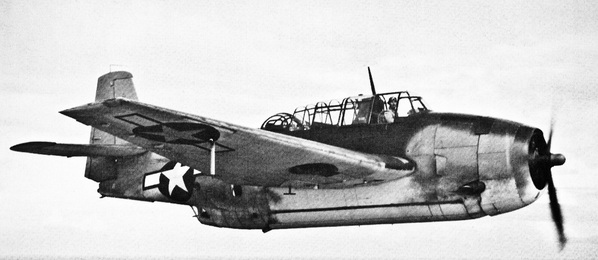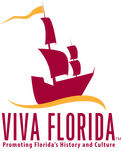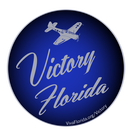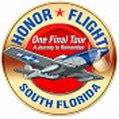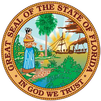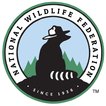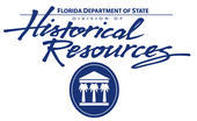Avenger Aircraft Exhibit
The Naval Air Station Fort Lauderdale (NASFL) was instrumental as thousands of men and women who went off to war received their training here. Most importantly, was the use of the Naval Air Station for training pilots and air crews on the Grumman Avenger TBF/TBM torpedo bomber, which was the largest single engine plane used during the war. By the end of the war, NASFL had trained thousands of American and British aviators on the Avenger Torpedo Bombers.
Notes on the Avenger Torpedo Bomber
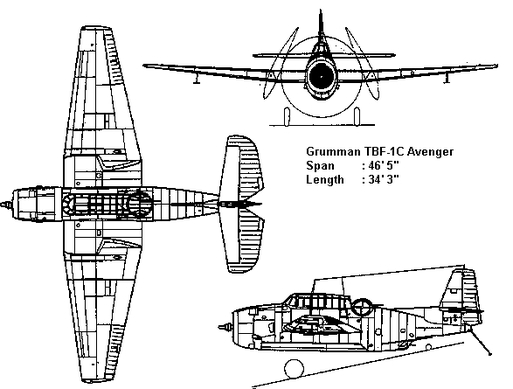
The Blueprint Database Creative Commons
- Folding wings
- Three seats
- Powered rear turret
- Three .30 caliber machine guns
- Large internal bay
- Empty Weight: 10,843 pounds
- Maximum Weight: 18,250 pounds
- Maximum Speed 267mph @ 16,000 feet
- Service ceiling: 23,400 feet
- Range: 1,130 miles
- Crew of three: Pilot, Turret Gunner and
Radioman/bombardier/ventral gunner.
NAS Fort Lauderdale Aircraft Paint Schemes
TBF and TBM are designations for the same type of aircraft which happened to be built in different factories by different companies. TBF= Torpedo Bomber Grumman TBM = Torpedo Bomber General Motors. During the war GM/Ford/Chrysler didn't build cars, they built planes, tanks, and jeeps designed by other companies. The Avenger was the first design to feature a new wing-folding mechanism created by Grumman, intended to maximize storage space on an aircraft carrier; the F4F-4 and later models of Wildcat received a similar folding wing and the F6F Hellcat (both designed by Grumman) employed this mechanism as well.
The engine used was the Wright R-2600-20. There were three crew members: pilot, turret gunner and radioman/bombardier/ventral gunner. One .30 caliber machine gun was mounted in the nose, a .50 caliber gun was mounted right next to the turret gunner's head, in a rear-facing electrically powered turret, and a single .30 caliber hand-fired machine gun mounted ventrally (under the tail), which was used to defend against enemy fighters attacking from below and to the rear. This gun was fired by the radioman/bombardier while standing up and bending over in the belly of the tail section, though he usually sat on a folding bench facing forward to operate the radio and to sight in bombing runs.
Later models of the TBF/TBM dispensed with the nose-mounted gun for one .50 caliber gun in each wing per pilots' requests for better forward firepower and increased strafing ability. There was only one set of controls on the aircraft, and no access to the pilot's position from the rest of the aircraft. The radio equipment was massive, especially by today's standards, and filled the whole glass canopy to the rear of the pilot. The radios were accessible for repair through a “tunnel” along the right hand side. Any Avengers that are still flying today usually have an additional rear-mounted seat in place of the radios, which increases crew to four.
The Avenger had a large bomb bay, allowing for one Bliss-Leavitt Mark 13 torpedo, a single 2,000 pound bomb, or up to four 500 pound bombs. The aircraft had overall ruggedness and stability, and pilots say it flew like a truck, for better or worse. With its good radio facilities, docile handling, and long range, the Grumman Avenger also made an ideal command aircraft for Commanders, Air Group (CAGs). With a 30,000 ft ceiling and a fully-loaded range of 1,000 miles, it was better than any previous American torpedo bomber and better than its Japanese counterpart: the obsolete Nakajima B5N "Kate".
Later Avenger models carried radar equipment for the ASW and AEW roles. Although improvements in new types of aviation radar were soon forthcoming from the engineers at MIT and the electronic industry, the available radars in 1943 were very bulky, as they contained vacuum tube technology. Because of this, radar was at first carried only on the roomy TBF Avengers, but not on the smaller and faster fighters. Escort carriers sailors referred to the TBF as the “turkey” because of its size and maneuverability in comparison to the F4F Wildcat fighters in CVE air-groups.
Typical Monthly Grumman TBF-1 GM TBM Total
Production
February, 1942 5 0 5
June, 1942 60 0 60
November, 1942 100 1 101
July, 1943 150 100 250
June, 1944 0 300 300
March, 1945 0 400 400
TOTAL 2,291 7,546 9,837
First Combat - Midway:
Only six TBF's actually entered front-line combat service in time for the critical Battle of Midway on June 4, 1942. These planes, attached to VT-8, flew up to Midway Island three days before. Commanded by Lieutenant Langdon K. Fieberling, none of the TBF pilots had ever been in combat, and only a few had ever flown out of sight of land before. (Most of this squadron, the famed Torpedo Squadron Eight, flew the outmoded Douglas Devastators from the carrier Hornet.) But both new and old planes were nearly wiped out. Lieutenant Fieberling's six TBFs reached the Japanese fleet at 7:10 AM, dropped to low altitude and bore on toward the carriers. Zeros swarmed around the vulnerable torpedo planes. Two TBFs were destroyed in the first attack, followed by three more. Realizing that he could not reach the carriers, Ensign Albert K. Earnest loosed his torpedo at a cruiser, then broke away with two Zeros after him. Earnest flew his shot-up TBF back to Midway, navigating "by guess and by God." Earnest's was the only TBF to return, with nothing but the trim tab for longitudinal control, with one wheel and the torpedo bay doors hanging open. Radioman 3rd Class Harrier H. Ferrier was injured and Seaman 1st Class Jay D. Manning, who was operating the .50 caliber machine gun turret, was killed during the attack.
Eastern Solomons - August 24, 1942:
After the Americans took Guadalcanal, Admiral Yamamoto wasted no time in organizing a large naval counter-strike. On the 24th of August, the opposing carrier forces met. This time, the US Navy had just two carriers: Saratoga and Enterprise. By August, enough TBF's had been delivered and worked their way through the pipeline to equip the two ships' air groups with 24 TBF's:
- VT-8 on "Sara," commanded by Cdr. Harold "Swede" Larsen
- VT-3 on the "Big E," led by Lt. Cdr. Charles M. Jett
Santa Cruz - October 26, 1942:
In the war's fourth big carrier engagement, the Avengers didn't do much damage. The two surviving carriers in the Pacific, Enterprise and Hornet, carried 14 Avengers each. In late October, the two U.S. flattops met the Japanese effort to seize Guadalcanal. The opposing fleets' patrol planes spotted each other in the early morning and both launched air strikes across the intervening 200 miles. Enterprise and Hornet sent out three strikes, totalling 73 planes: 18 Avengers, 32 dive bombers, and 23 F4F fighters.
Commanding Torpedo Ten, VT-10, from Enterprise was Lt. Cdr. John A. Collett. He led his torpedo bombers westward, toward the Japanese ships, passing Zeros and Vals heading for the American ships. When the U.S planes found their targets, the Japanese combat air patrol and anti-aircraft knocked most of them down. The SBD's damaged the carrier, and the TBF's were shot out of the sky. A Zero shot up Lt. Cdr. Collett's Avenger. He and his radioman, ARM1/c Thomas C. Nelson were seen parachuting. Nelson was captured and survived as a POW. Collett was never seen again.
These early battles showed the strengths and weaknesses of the Avenger. Perhaps its biggest weakness was not actually a problem with the aircraft itself, but rather with the deficient torpedoes used by the US Navy in the first two years of the war. The Mark 13 torpedoes were fragile, and had to be dropped from a low height, at speeds below 130 MPH. The torpedoes under-ran their indicated depth by 11 feet and many would fail to explode when hitting a target or sometimes they would blow up prematurely. Therefore the TBF's flew a lot of missions with ordinary 500 lb. bombs. The aircraft itself was sound and could be used in various roles: torpedo bomber, glide bomber, reconnaissance, mine-layer, and scout plane. With its good radio facilities, docile handling, long range, and extra seating, it made an ideal command aircraft for Air Group Commanders (CAGs).
Sinking the Hiei - Guadalcanal:
In November, 1942, TBF's from the Navy and Marine Corps led by Lt. Col. Paul Moret, Marine Scout Bombing Squadron 131 (VMSB-131), flew TBF-1 Avengers from Guadalcanal during this pivotal month. Leading the powerful Japanese naval forces was the Hiei, a 37,000 ton battleship. Through the night of the 12th-13th, the American and Japanese surface ships pounded each other, and the Japanese pulverized Henderson Field with 14-inch explosive shells, in the naval Battle of Guadalcanal. The US Navy lost 2 cruisers and 4 destroyers, while sinking 2 Japanese destroyers and crippling the battleship Hiei. But in the morning, the U.S planes could still use their cratered airstrip. And the carrier Enterprise lurked 300 miles to the south. At 6 am, dive bombers from Henderson hit Hiei. An hour later, Moret's Marine Corps TBF's put a torpedo in the drifting battleship. At 11:30, two torpedoes launched from Grumman TBF Avenger torpedo-bombers struck Hiei. After several more torpedo and dive-bomber attacks throughout the day, the order was given for her crew to abandon ship before her escorting destroyers scuttled her. The Hiei sank sometime in the evening on 14 November with 188 of her crew.
O'Hare - November 1943:
In late 1943, the US Navy began its first systematic night fighting teams. Ace pilot Ed O'Hare, then with the CAG Enterprise, was involved in developing night fighter tactics. As the primitive radars were very bulky, they were carried on the Enterprise, on the roomy TBF Avengers, but not on the smaller and faster Hellcats. The plan required the ship's Fighter Director Officer (FDO) to spot the incoming Betty's at a distance and send the Avengers and Hellcats toward them. The radar-equipped Avengers would then lead the Hellcats into position behind the incoming bombers, close enough for the Hellcat pilots to spot visually the Betty's blue exhaust flames. Finally, the Hellcats would close in and shoot down the bombers. All the planes on both sides would be flying at low level. The plan was experimental, complicated, and risky. The night of November 26 - 27, 1943 was the first combat test of the plan, following an earlier mission that hadn't contacted the Japanese forces. The 'Black Panthers', as the night fighters were dubbed, included two sections of three planes. Both included two Hellcats and one Avenger. In the confusing night action, O'Hare went down, most likely the victim of a lucky shot from the Betty, but possibly due to friendly fire.
The U-Boat War:
In the struggle for the North Atlantic, Avengers were credited with destroying 30 submarines, including the unique sinking of the Japanese cargo submarine I-52. Flying from escort carriers (CVEs), the TBFs were well-suited with long endurance, stable and a large weapons capacity. They became the key strike aircraft in the hunter-killer groups that ranged the Atlantic: CVE's flying Avengers and Wildcats with destroyers in support.
Sinking of I-52:
In 1943 the Japanese and Germans worked out a plan to exchange critical materials via specialized cargo submarines: opium, rubber, quinine, tungsten, and molybdenum from the Japanese in exchange of German radar, bombsights, vacuum tubes, optical glass, ball bearings, etc.. In March, 1944, the I-52 departed Kure, picked up cargo in Singapore and headed through the Indian Ocean, all monitored by U.S intelligence. It rendezvoused with the German sub U-530 on June 23, in the mid-Atlantic, and picked up a German pilot who would guide I-52 into port at Lorient. There, the exchange was planned to take place.
But Allied intercepts had pinpointed I-52's movements and its cargo. Within hours of I-52's meeting with U-530, this information had been relayed to Bogue. The commander of its Composite Squadron 69 (VC-69), Lt. Cdr. Jesse Taylor, immediately took off in his TBF in pursuit of the Japanese submarine. As Taylor patrolled in the darkness, his radarman, Chief Ed Whitlock, picked up a blip. They went after it and dropped flares, lighting up the 350-foot long cargo sub. Taylor closed in, dropping two depth bombs. I-52 dived and the TBF dropped a sonobuoy into the water. The newly-developed sonobuoys picked up long-carrying underwater noises and transmitted these back to the carrier. Following the sonobuoy's signal, Taylor dropped a Mark 24 "Fido" acoustic torpedo. The sonobuoy transmitted the crunching sound of explosions back to Bogue. While Taylor thought he had sunk the sub, other Avengers soon picked up propeller beats. Bogue's CO, Captain A. B. Vosseller, ordered a second attack; William "Flash" Gordon flew his TBF to the site and dropped another torpedo. The I-52 quickly went to the bottom, with a massive hole in her hull.
For over 50 years, I-52 lay at the bottom of the Atlantic. In 1998, the National Geographic Society sponsored a deep-sea submersible mission which found the I-52's remains. The October, 1999 issue featured this dramatic story.
Into the Night - June 20, 1944:
After the U.S Navy's Hellcats destroyed over 350 Japanese planes in the "Marianas Turkey Shoot," Admiral Marc Mitscher wanted to follow up the aerial victory and sink the Japanese carriers as well. All day, and into the afternoon, Task Force 58's search planes, probed westward for the fleeing enemy ships. Eventually, at 3:40 pm, Avenger pilot Lt. R.S. Nelson, from Enterprise, found Ozawa's force 275 miles to the west. Mitscher ordered an immediate strike. By 4:10 pm the planes were launched. Nonetheless, the risk to pilots was grave: there just wasn't enough daylight left for them to reach their quarry, hit targets, and return. Mitscher's gamble reflected the cold and brutal calculus of war - he hoped his air crew losses would cost his side less than the damage they could do to the other side's ships. A couple hours later, at the extreme end of their range, the TBFs, Hellcats, and dive bombers caught the Japanese fleet.
Avengers from CVL-24 Belleau Wood sank the light carrier Hiyo. Belleau Wood's Air Group 24 launched 12 planes, including a division of four Avengers piloted by Lt. George P. Brown in the lead, Lt. Warren Omark, Benjamin C. Tate, and W.D. Luton. All four Avengers were armed with torpedoes. When they spotted the Japanese carrier, Brown ordered the planes to fan out and approach from different angles. They dove through intense anti-aircraft fire, which struck Brown's TBF. George Platz and Ellis Babcock, the two crewmen in Brown's plane, realized their plane was afire and unable to reach Brown on the intercom, they parachuted and witnessed the attack from the water. The wounded Brown grimly held his Avenger on track. He, Omark, and Tate launched their improved torpedos at the carrier. They struck home and the two aircrewmen in the water saw Hiyo sink 30 minutes later. Brown and his plane disappeared. Omark flew back and made a nighttime landing on Lexington. Tate and Luton also flew back, had to ditch, and were recovered safely. American search planes rescued Platz and Babcock the next day.
The TBF's sinking of Hiyo was the only serious damage done to Japanese fighting ships by the 227 planes of the "mission beyond darkness." The Avengers' experience was typical of the day: 54 planes successfully launched, 29 of these were lost, plus 8 more operational losses. From these 37 planes, about 111 men went into the water - 67 were rescued. But a lot of brave young aviators died that day. Mitscher's gamble was probably correct, it just didn't pay off as well as all had hoped.
George Bush:
Undoubtedly, the most famous man to fly an Avenger was George H.W. Bush, later the 41st President of the United States. He joined the Navy in 1942, and became the youngest naval aviator ever in June, 1943. Bush trained and lived in the Junior Officers Bachelor Quarters at Naval Air Station Fort Lauderdale during the summer of 1943 where he trained as a torpedo/bomber pilot. He was assigned to Instructor Lt. Thomas "Tex" Ellison USN (uncle of former Fort Lauderdale Mayor Jim Naugle). Lt Ellison had just returned from combat in the Pacific theater when he was commissioned as an experienced Instructor. Bush flew Avengers with VT-51, from USS San Jacinto. On September 2, 1944 he was shot down over Chichi Jima. While Bush parachuted safely and was rescued, neither of his crewmen survived. Bush earned a DFC for delivering his bombload after his TBF Avenger had been hit.
In the war's fourth big carrier engagement, the Avengers didn't do much damage. The two surviving carriers in the Pacific, Enterprise and Hornet, carried 14 Avengers each. In late October, the two U.S. flattops met the Japanese effort to seize Guadalcanal. The opposing fleets' patrol planes spotted each other in the early morning and both launched air strikes across the intervening 200 miles. Enterprise and Hornet sent out three strikes, totalling 73 planes: 18 Avengers, 32 dive bombers, and 23 F4F fighters.
Commanding Torpedo Ten, VT-10, from Enterprise was Lt. Cdr. John A. Collett. He led his torpedo bombers westward, toward the Japanese ships, passing Zeros and Vals heading for the American ships. When the U.S planes found their targets, the Japanese combat air patrol and anti-aircraft knocked most of them down. The SBD's damaged the carrier, and the TBF's were shot out of the sky. A Zero shot up Lt. Cdr. Collett's Avenger. He and his radioman, ARM1/c Thomas C. Nelson were seen parachuting. Nelson was captured and survived as a POW. Collett was never seen again.
These early battles showed the strengths and weaknesses of the Avenger. Perhaps its biggest weakness was not actually a problem with the aircraft itself, but rather with the deficient torpedoes used by the US Navy in the first two years of the war. The Mark 13 torpedoes were fragile, and had to be dropped from a low height, at speeds below 130 MPH. The torpedoes under-ran their indicated depth by 11 feet and many would fail to explode when hitting a target or sometimes they would blow up prematurely. Therefore the TBF's flew a lot of missions with ordinary 500 lb. bombs. The aircraft itself was sound and could be used in various roles: torpedo bomber, glide bomber, reconnaissance, mine-layer, and scout plane. With its good radio facilities, docile handling, long range, and extra seating, it made an ideal command aircraft for Air Group Commanders (CAGs).
Sinking the Hiei - Guadalcanal:
In November, 1942, TBF's from the Navy and Marine Corps led by Lt. Col. Paul Moret, Marine Scout Bombing Squadron 131 (VMSB-131), flew TBF-1 Avengers from Guadalcanal during this pivotal month. Leading the powerful Japanese naval forces was the Hiei, a 37,000 ton battleship. Through the night of the 12th-13th, the American and Japanese surface ships pounded each other, and the Japanese pulverized Henderson Field with 14-inch explosive shells, in the naval Battle of Guadalcanal. The US Navy lost 2 cruisers and 4 destroyers, while sinking 2 Japanese destroyers and crippling the battleship Hiei. But in the morning, the U.S planes could still use their cratered airstrip. And the carrier Enterprise lurked 300 miles to the south. At 6 am, dive bombers from Henderson hit Hiei. An hour later, Moret's Marine Corps TBF's put a torpedo in the drifting battleship. At 11:30, two torpedoes launched from Grumman TBF Avenger torpedo-bombers struck Hiei. After several more torpedo and dive-bomber attacks throughout the day, the order was given for her crew to abandon ship before her escorting destroyers scuttled her. The Hiei sank sometime in the evening on 14 November with 188 of her crew.
O'Hare - November 1943:
In late 1943, the US Navy began its first systematic night fighting teams. Ace pilot Ed O'Hare, then with the CAG Enterprise, was involved in developing night fighter tactics. As the primitive radars were very bulky, they were carried on the Enterprise, on the roomy TBF Avengers, but not on the smaller and faster Hellcats. The plan required the ship's Fighter Director Officer (FDO) to spot the incoming Betty's at a distance and send the Avengers and Hellcats toward them. The radar-equipped Avengers would then lead the Hellcats into position behind the incoming bombers, close enough for the Hellcat pilots to spot visually the Betty's blue exhaust flames. Finally, the Hellcats would close in and shoot down the bombers. All the planes on both sides would be flying at low level. The plan was experimental, complicated, and risky. The night of November 26 - 27, 1943 was the first combat test of the plan, following an earlier mission that hadn't contacted the Japanese forces. The 'Black Panthers', as the night fighters were dubbed, included two sections of three planes. Both included two Hellcats and one Avenger. In the confusing night action, O'Hare went down, most likely the victim of a lucky shot from the Betty, but possibly due to friendly fire.
The U-Boat War:
In the struggle for the North Atlantic, Avengers were credited with destroying 30 submarines, including the unique sinking of the Japanese cargo submarine I-52. Flying from escort carriers (CVEs), the TBFs were well-suited with long endurance, stable and a large weapons capacity. They became the key strike aircraft in the hunter-killer groups that ranged the Atlantic: CVE's flying Avengers and Wildcats with destroyers in support.
Sinking of I-52:
In 1943 the Japanese and Germans worked out a plan to exchange critical materials via specialized cargo submarines: opium, rubber, quinine, tungsten, and molybdenum from the Japanese in exchange of German radar, bombsights, vacuum tubes, optical glass, ball bearings, etc.. In March, 1944, the I-52 departed Kure, picked up cargo in Singapore and headed through the Indian Ocean, all monitored by U.S intelligence. It rendezvoused with the German sub U-530 on June 23, in the mid-Atlantic, and picked up a German pilot who would guide I-52 into port at Lorient. There, the exchange was planned to take place.
But Allied intercepts had pinpointed I-52's movements and its cargo. Within hours of I-52's meeting with U-530, this information had been relayed to Bogue. The commander of its Composite Squadron 69 (VC-69), Lt. Cdr. Jesse Taylor, immediately took off in his TBF in pursuit of the Japanese submarine. As Taylor patrolled in the darkness, his radarman, Chief Ed Whitlock, picked up a blip. They went after it and dropped flares, lighting up the 350-foot long cargo sub. Taylor closed in, dropping two depth bombs. I-52 dived and the TBF dropped a sonobuoy into the water. The newly-developed sonobuoys picked up long-carrying underwater noises and transmitted these back to the carrier. Following the sonobuoy's signal, Taylor dropped a Mark 24 "Fido" acoustic torpedo. The sonobuoy transmitted the crunching sound of explosions back to Bogue. While Taylor thought he had sunk the sub, other Avengers soon picked up propeller beats. Bogue's CO, Captain A. B. Vosseller, ordered a second attack; William "Flash" Gordon flew his TBF to the site and dropped another torpedo. The I-52 quickly went to the bottom, with a massive hole in her hull.
For over 50 years, I-52 lay at the bottom of the Atlantic. In 1998, the National Geographic Society sponsored a deep-sea submersible mission which found the I-52's remains. The October, 1999 issue featured this dramatic story.
Into the Night - June 20, 1944:
After the U.S Navy's Hellcats destroyed over 350 Japanese planes in the "Marianas Turkey Shoot," Admiral Marc Mitscher wanted to follow up the aerial victory and sink the Japanese carriers as well. All day, and into the afternoon, Task Force 58's search planes, probed westward for the fleeing enemy ships. Eventually, at 3:40 pm, Avenger pilot Lt. R.S. Nelson, from Enterprise, found Ozawa's force 275 miles to the west. Mitscher ordered an immediate strike. By 4:10 pm the planes were launched. Nonetheless, the risk to pilots was grave: there just wasn't enough daylight left for them to reach their quarry, hit targets, and return. Mitscher's gamble reflected the cold and brutal calculus of war - he hoped his air crew losses would cost his side less than the damage they could do to the other side's ships. A couple hours later, at the extreme end of their range, the TBFs, Hellcats, and dive bombers caught the Japanese fleet.
Avengers from CVL-24 Belleau Wood sank the light carrier Hiyo. Belleau Wood's Air Group 24 launched 12 planes, including a division of four Avengers piloted by Lt. George P. Brown in the lead, Lt. Warren Omark, Benjamin C. Tate, and W.D. Luton. All four Avengers were armed with torpedoes. When they spotted the Japanese carrier, Brown ordered the planes to fan out and approach from different angles. They dove through intense anti-aircraft fire, which struck Brown's TBF. George Platz and Ellis Babcock, the two crewmen in Brown's plane, realized their plane was afire and unable to reach Brown on the intercom, they parachuted and witnessed the attack from the water. The wounded Brown grimly held his Avenger on track. He, Omark, and Tate launched their improved torpedos at the carrier. They struck home and the two aircrewmen in the water saw Hiyo sink 30 minutes later. Brown and his plane disappeared. Omark flew back and made a nighttime landing on Lexington. Tate and Luton also flew back, had to ditch, and were recovered safely. American search planes rescued Platz and Babcock the next day.
The TBF's sinking of Hiyo was the only serious damage done to Japanese fighting ships by the 227 planes of the "mission beyond darkness." The Avengers' experience was typical of the day: 54 planes successfully launched, 29 of these were lost, plus 8 more operational losses. From these 37 planes, about 111 men went into the water - 67 were rescued. But a lot of brave young aviators died that day. Mitscher's gamble was probably correct, it just didn't pay off as well as all had hoped.
George Bush:
Undoubtedly, the most famous man to fly an Avenger was George H.W. Bush, later the 41st President of the United States. He joined the Navy in 1942, and became the youngest naval aviator ever in June, 1943. Bush trained and lived in the Junior Officers Bachelor Quarters at Naval Air Station Fort Lauderdale during the summer of 1943 where he trained as a torpedo/bomber pilot. He was assigned to Instructor Lt. Thomas "Tex" Ellison USN (uncle of former Fort Lauderdale Mayor Jim Naugle). Lt Ellison had just returned from combat in the Pacific theater when he was commissioned as an experienced Instructor. Bush flew Avengers with VT-51, from USS San Jacinto. On September 2, 1944 he was shot down over Chichi Jima. While Bush parachuted safely and was rescued, neither of his crewmen survived. Bush earned a DFC for delivering his bombload after his TBF Avenger had been hit.
George H.W. Bush (second from right top row) and a group of pilots in training at the Naval Air Station Fort Lauderdale.
Their instructor Capt. Thomas "Tex" Ellison is at far right. Copyright © NAS Fort Lauderdale Museum.
Their instructor Capt. Thomas "Tex" Ellison is at far right. Copyright © NAS Fort Lauderdale Museum.
Avengers at NAS Fort Lauderdale
- Click on images to enlarge and read descriptions -
October, 1944:
Avengers played a key role in sinking the Japanese super-battleship Musashi in the Battle of the Sibuyan Sea and in the next day's related action, the Battle of Leyte Gulf, CVE-based Avengers helped stave off the Japanese surface ships. TBF's also helped to sink Zuikaku and three light carriers on the 26th.
Lt. Cdr. Edward Huxtable, CO of Gambier Bay's VC-10, directed the Avengers and Wildcats in their attacks on the heavy Japanese ships. When Admiral Kurita's 4 battleships and 8 cruisers appeared off Samar on the morning of Oct.25, Gambier Bay and the other CVE's of Task Force 3 were exposed. Huxtable's TBM only had 100 rounds of .50 caliber ammunition, but he and other pilots made dummy runs on the Japanese fleet. After sinking Gambier Bay and three destroyers, the Japanese concluded that they were facing Essex-class carriers and they steamed back through San Bernardino Strait.
The End:
1945 Grumman's torpedo bombers sank the Yamato, in its last desperate run for Okinawa on April 7, 1945.
At the 1997 ceremonies for the Enlisted Combat Aircrew Roll of Honor, Yorktown veteran, Charles G. Fries, Jr. ARM2/C, a TBM tail gunner, described the attack.
"In April 1945, we went after the last remnants of the Japanese Fleet, which comprised the battleship Yamato, the cruiser Yahagi, and two screen destroyers. When we went to look for them it was overcast, and the TBF crews had to find them, which we did. When we came into range, the squadrons split into two sections. The Admirals wanted very badly to bring down the battleship, and if necessary every airplane would hit it. It turned out, that was not necessary. The first TBM's got the wagon, and she was severely damaged, ready to sink.
So we went after the cruiser, whose armor plating was at a different depth. In consequence we had to change the depth setting on the torpedo so it wouldn't go under the cruiser, so it would hit Yahagi at the appropriate point and put a hole in her.
It was a little hairy because you couldn't see what you were doing. You could only get in there up to your armpit, so you were feeling your way. The wrench that turned the indicator changed the depth setting. This was right next to the arming wires that ran from the bulkhead to the torpedo's fuse. If you pulled the wrong wire, we were told the air stream coming through could actually arm the torpedo. If it were hit in any way it could have been a problem to us.
We changed the depth setting and went after the cruiser. Both big ships and the destroyers put up a lot of flak. After firing our torpedo, we were pleased to see the cruiser go down. Later another destroyer went down too. One pilot's torpedo hung up and he had to make two more runs. He got the torpedo off, so we sank three of the four Japanese ships. As far as we were concerned, the Japanese fleet was no more.
As young kids, we were so elated to see those ships go down. The wagon rolled over on her side and eventually went under. The cruiser slipped up into the air, bow first and then slid back down into the water like a toy. My first feeling of elation recalled the Pearl Harbor attack. We felt like we were getting even. However that was soon followed by a great feeling of sadness.
It was strange to see all the Japanese sailors in the water, and wondering to this day if there were any survivors. If there were, I would truly like to talk to them and get their side of the story. At this point in our lives, in our middle seventies, we are more reflective. We realize that it's young kids who go to war. I don't know who starts them, but it is not pleasant to consider all those fellows that didn't make it, were somebody's son. They were only kids doing what they were told, the same as we were. So in this point of one's life, there isn't any malice left."
Post War:
After the war, Avengers continued flying in the U.S. Navy, primarily in anti-submarine, Electronic Counter-Measures (ECM), as missile platforms, and for training. Large numbers of Avengers found postwar roles with Canada, France, Japan and the Netherlands, some still serving in 1960. Some were converted to civilian use as fire-fighters.
The Navy continued to operate 7 different modified models of the Avenger after WWII, until the last model was withdrawn in 1955.
Most WWII Avenger missions were horizontal or glide bombing attacks, due to the unreliable torpedo in use. Late war improvements in the torpedo allowed limited use, but post-war tactics ended daylight use of the torpedo attack tactic. However, the Navy developed the TBM-3N in late 1945 as a night torpedo bomber. Approximately 45 a/c were modified by the removal of the turret and a short- range radar with a new bombing
system installed. A radar increased systems/bombing operators crew position built up in the aft fuselage. The a/c served with VCM-1&2 into the early 1950’s.
The buildup of the postwar Russian submarine fleet was in its early stage helped by the capture of 2 of the latest models of German U boats, along with German studies of
advanced boats which posed an extreme threat to free world shipping and Navies. The Navy developed numerous systems and tactics to counter this threat, many of which were
improvements to existing systems.
The Avenger a/c was a key asset in a number of these improvements. Exploiting the highly successful “Hunter-Killer Groups”, first developed in late 1942, for North Atlantic ASW operations, these wartime Hunter-Killer groups, operating with other ASW assets, sank 53 German U boats and 11 Japanese boats. Post war Hunter-Killer improvements included basing the air group on now available light carriers which
provided 20 knots in additional speed, replacing assigned DD and DE escort ships with the latest available ships, and lastly using 2 new Avenger models in the air group. The
TBM-3 Hunter was a model which deleted all armaments, including the turret, and added a radar with an 11- foot antenna in a large belly radiomen.
The single radar operator in the aft fuselage controlled the search radar with a 90 mile range. The operator could transfer received target data, through a data link, to the Killer” a/c or to the aircraft carrier CIC-3. 152 of the newly built a/c were purchased. The “Killer” a/c of the team was a modified TBM-3E to the TBM-3S model, of which approximately 200 a/c were modified. Again, the turret and torpedo equipment was
deleted. A short- range radar was installed with the radar systems 12” antenna mounted on the right wing. In the same position on the left wing, a crew operated searchlight was installed. The -3S had both a radar/bombardier and a data link/sonar operator crew member in 2 positions in the aft fuselage. The received radar information from the Hunter a/c and the on- board radar and sonar systems enabled the “Killer” to attack a target found with 8 wing mounted 5” rockets, 6 bombs, 4 depth charges or 2 acoustic homing torpedoes. The a/c team served until 1954, when it was replaced by another Grumman team, the AF-1 aircraft.
Another modification created the last serving Avenger model. Advances in post war radio avionics allowed the unit to be reduced in size and were given a remote tuning capability. This allowed the fuselage mounted equipment to then fit on a shelf behind the pilot’s seat, and a radio operator was no longer required. Grumman designed the TBM-3R, “carrier on board delivery” a/c which took advantage of the new large empty fuselage
space. 7 passenger seats were mounted there, along with a newly designed bomb bay cargo basket. About 25 a/c then began Korean War support flights to at sea aircraft carriers transporting personal and supplies from Japan out to the carriers. The “COD support mission concept continued through today, using several models of Grumman aircraft and then in 2021 with the introduction of the CMU-22B Tiltrotor a/c. The last TBM-3R mission was flown in late 1954.
Wartime production saw 4000 TBM-3 a/c built and 650 of the improved TBM-3E. In post war service, the radar equipped -3E served in 18 torpedo squadrons. When the torpedo bombing mission ended, the a/c then served as a level or glide bomber in the newly formed attack squadrons. The final service of the Avenger in the attack role ended in 1949, with it being replaced by the A-1 Sky Raider.
The 13 years of the sterling Avenger service to the Navy, surely earned it a place of honor in the family of the “Grumman Ironworks”.
Avengers played a key role in sinking the Japanese super-battleship Musashi in the Battle of the Sibuyan Sea and in the next day's related action, the Battle of Leyte Gulf, CVE-based Avengers helped stave off the Japanese surface ships. TBF's also helped to sink Zuikaku and three light carriers on the 26th.
Lt. Cdr. Edward Huxtable, CO of Gambier Bay's VC-10, directed the Avengers and Wildcats in their attacks on the heavy Japanese ships. When Admiral Kurita's 4 battleships and 8 cruisers appeared off Samar on the morning of Oct.25, Gambier Bay and the other CVE's of Task Force 3 were exposed. Huxtable's TBM only had 100 rounds of .50 caliber ammunition, but he and other pilots made dummy runs on the Japanese fleet. After sinking Gambier Bay and three destroyers, the Japanese concluded that they were facing Essex-class carriers and they steamed back through San Bernardino Strait.
The End:
1945 Grumman's torpedo bombers sank the Yamato, in its last desperate run for Okinawa on April 7, 1945.
At the 1997 ceremonies for the Enlisted Combat Aircrew Roll of Honor, Yorktown veteran, Charles G. Fries, Jr. ARM2/C, a TBM tail gunner, described the attack.
"In April 1945, we went after the last remnants of the Japanese Fleet, which comprised the battleship Yamato, the cruiser Yahagi, and two screen destroyers. When we went to look for them it was overcast, and the TBF crews had to find them, which we did. When we came into range, the squadrons split into two sections. The Admirals wanted very badly to bring down the battleship, and if necessary every airplane would hit it. It turned out, that was not necessary. The first TBM's got the wagon, and she was severely damaged, ready to sink.
So we went after the cruiser, whose armor plating was at a different depth. In consequence we had to change the depth setting on the torpedo so it wouldn't go under the cruiser, so it would hit Yahagi at the appropriate point and put a hole in her.
It was a little hairy because you couldn't see what you were doing. You could only get in there up to your armpit, so you were feeling your way. The wrench that turned the indicator changed the depth setting. This was right next to the arming wires that ran from the bulkhead to the torpedo's fuse. If you pulled the wrong wire, we were told the air stream coming through could actually arm the torpedo. If it were hit in any way it could have been a problem to us.
We changed the depth setting and went after the cruiser. Both big ships and the destroyers put up a lot of flak. After firing our torpedo, we were pleased to see the cruiser go down. Later another destroyer went down too. One pilot's torpedo hung up and he had to make two more runs. He got the torpedo off, so we sank three of the four Japanese ships. As far as we were concerned, the Japanese fleet was no more.
As young kids, we were so elated to see those ships go down. The wagon rolled over on her side and eventually went under. The cruiser slipped up into the air, bow first and then slid back down into the water like a toy. My first feeling of elation recalled the Pearl Harbor attack. We felt like we were getting even. However that was soon followed by a great feeling of sadness.
It was strange to see all the Japanese sailors in the water, and wondering to this day if there were any survivors. If there were, I would truly like to talk to them and get their side of the story. At this point in our lives, in our middle seventies, we are more reflective. We realize that it's young kids who go to war. I don't know who starts them, but it is not pleasant to consider all those fellows that didn't make it, were somebody's son. They were only kids doing what they were told, the same as we were. So in this point of one's life, there isn't any malice left."
Post War:
After the war, Avengers continued flying in the U.S. Navy, primarily in anti-submarine, Electronic Counter-Measures (ECM), as missile platforms, and for training. Large numbers of Avengers found postwar roles with Canada, France, Japan and the Netherlands, some still serving in 1960. Some were converted to civilian use as fire-fighters.
The Navy continued to operate 7 different modified models of the Avenger after WWII, until the last model was withdrawn in 1955.
Most WWII Avenger missions were horizontal or glide bombing attacks, due to the unreliable torpedo in use. Late war improvements in the torpedo allowed limited use, but post-war tactics ended daylight use of the torpedo attack tactic. However, the Navy developed the TBM-3N in late 1945 as a night torpedo bomber. Approximately 45 a/c were modified by the removal of the turret and a short- range radar with a new bombing
system installed. A radar increased systems/bombing operators crew position built up in the aft fuselage. The a/c served with VCM-1&2 into the early 1950’s.
The buildup of the postwar Russian submarine fleet was in its early stage helped by the capture of 2 of the latest models of German U boats, along with German studies of
advanced boats which posed an extreme threat to free world shipping and Navies. The Navy developed numerous systems and tactics to counter this threat, many of which were
improvements to existing systems.
The Avenger a/c was a key asset in a number of these improvements. Exploiting the highly successful “Hunter-Killer Groups”, first developed in late 1942, for North Atlantic ASW operations, these wartime Hunter-Killer groups, operating with other ASW assets, sank 53 German U boats and 11 Japanese boats. Post war Hunter-Killer improvements included basing the air group on now available light carriers which
provided 20 knots in additional speed, replacing assigned DD and DE escort ships with the latest available ships, and lastly using 2 new Avenger models in the air group. The
TBM-3 Hunter was a model which deleted all armaments, including the turret, and added a radar with an 11- foot antenna in a large belly radiomen.
The single radar operator in the aft fuselage controlled the search radar with a 90 mile range. The operator could transfer received target data, through a data link, to the Killer” a/c or to the aircraft carrier CIC-3. 152 of the newly built a/c were purchased. The “Killer” a/c of the team was a modified TBM-3E to the TBM-3S model, of which approximately 200 a/c were modified. Again, the turret and torpedo equipment was
deleted. A short- range radar was installed with the radar systems 12” antenna mounted on the right wing. In the same position on the left wing, a crew operated searchlight was installed. The -3S had both a radar/bombardier and a data link/sonar operator crew member in 2 positions in the aft fuselage. The received radar information from the Hunter a/c and the on- board radar and sonar systems enabled the “Killer” to attack a target found with 8 wing mounted 5” rockets, 6 bombs, 4 depth charges or 2 acoustic homing torpedoes. The a/c team served until 1954, when it was replaced by another Grumman team, the AF-1 aircraft.
Another modification created the last serving Avenger model. Advances in post war radio avionics allowed the unit to be reduced in size and were given a remote tuning capability. This allowed the fuselage mounted equipment to then fit on a shelf behind the pilot’s seat, and a radio operator was no longer required. Grumman designed the TBM-3R, “carrier on board delivery” a/c which took advantage of the new large empty fuselage
space. 7 passenger seats were mounted there, along with a newly designed bomb bay cargo basket. About 25 a/c then began Korean War support flights to at sea aircraft carriers transporting personal and supplies from Japan out to the carriers. The “COD support mission concept continued through today, using several models of Grumman aircraft and then in 2021 with the introduction of the CMU-22B Tiltrotor a/c. The last TBM-3R mission was flown in late 1954.
Wartime production saw 4000 TBM-3 a/c built and 650 of the improved TBM-3E. In post war service, the radar equipped -3E served in 18 torpedo squadrons. When the torpedo bombing mission ended, the a/c then served as a level or glide bomber in the newly formed attack squadrons. The final service of the Avenger in the attack role ended in 1949, with it being replaced by the A-1 Sky Raider.
The 13 years of the sterling Avenger service to the Navy, surely earned it a place of honor in the family of the “Grumman Ironworks”.
Museum's Books | Memberships | Newsletter | NASFL History | Flight 19 | Memorial | Volunteer | Media Kit | Veterans History | Links
|
Copyright © NAS Fort Lauderdale Museum
For use of images or text please contact webmaster Website created by Moonrisings, August 3, 2010 |
